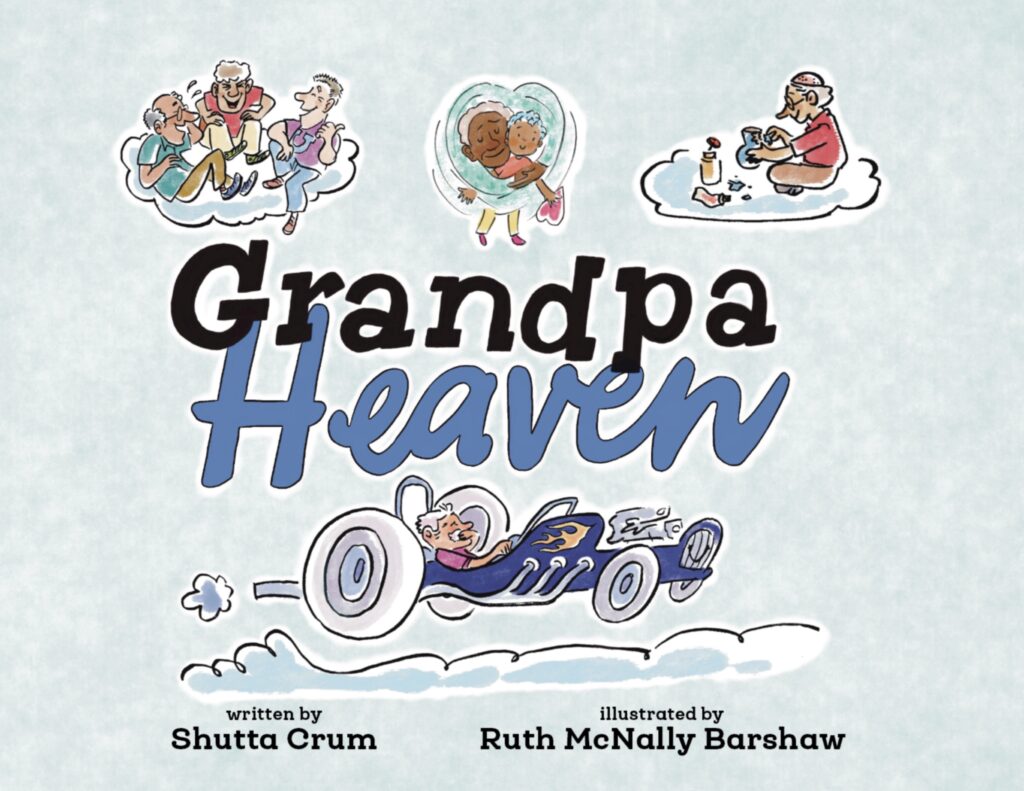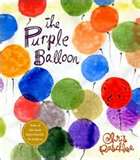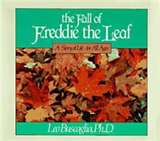“Grandma Heaven” and “Grandpa Heaven”


Shutta Crum and Ruth McNally Barshaw are two of my most favorite people in the kid lit world. They have two new books out, “Grandma Heaven” and “Grandpa Heaven” that sweetly feature my own parents as two of the people enjoying the afterlife.
Is Heaven a fun-filled place of laughter, companionship, and love? Who knows. Perhaps it’s
simply a state of the universal/eternal mind. Regardless, Shutta Crum knows that here in this
corporeal world there are young worriers who’ve suddenly lost a beloved grandparent, and those
bereft children need to be consoled. Shutta began working on Grandma Heaven and Grandpa
Heaven years ago when her four-year-old grandchild asked, “Are you going to die, Grammy?”
Shutta reassured her granddaughter that that was not going to happen for a long time. But the
child’s question sparked the idea for these two books about grandparents having a great time in
Heaven. The grandparents drive snazzy cars in Heaven, study prehistoric animals, have pets,
bake, read, knit, bowl, tinker with broken things, and zip in on zip-lines. But the most important
job of a grandparent in the afterlife is watching over all the grandchildren of the world and
sending the memory of a hug when it is needed. Importantly, these two books are non-religious
and multicultural. Heaven in Grandma Heaven and Grandpa Heaven is populated by
grandparents from around the world so that all children can rest assured that their grandparents’
love never dies.
Grandma Heaven and Grandpa Heaven (published by Lawley Books, 2023) can be found online
wherever books are sold. Also, ask for them at your local bookstore, or to be purchased by your
local library. Paperback editions available: Sept. 28, 2023. Spanish editions: January 2024.
What to Read After a Tragedy Occurs
 Sometimes the unthinkable happens. In Aurora, Colorado, someone came into a movie theater and began shooting innocent people. Twelve people were killed, fifty-eight more were wounded. All of us are horrified by the random violence.
Sometimes the unthinkable happens. In Aurora, Colorado, someone came into a movie theater and began shooting innocent people. Twelve people were killed, fifty-eight more were wounded. All of us are horrified by the random violence.
What do we tell our children when these tragedies occur? We shield them as much as we can, but too often our kids overhear more than we’d like. How do we find the words that can make sense of the senseless?
I turned to my wise author/illustrator friend, Jean Gralley, for advice. She wrote what one reviewer called, “perhaps the best ‘crisis’ book ever published” for children: The Moon Came Down on Milk Street.
“Bad things happen in this world,” Jean wrote. “We know it; kids know it, too. When adults side-step a necessary conversation about this, lie about it or pretend it isn’t so, children realize we are being un-truthful and our discomfort only adds to their anxiety. (After Sept. 11) I instantly wanted to write and illustrate a picture book that allows adults and children a point of view and a “way in” to that conversation.
In this simple story an unnatural event gently takes place: the moon slowly, softly falls out of the sky onto a city street. When the narrator asks, “Who will make this right again?” Various voices answer, “I will!” and “We will!” and over the course of the story we watch the many helpers inventively and imaginatively repair the moon and set it back in the night sky.
In a time of natural disasters and emergencies of all kinds, kids worry. They worry about things that have happened and haven’t happened yet. It’s important we take the first steps and let them know we’re ready to listen to their thoughts, questions, and feelings, what makes them afraid. The Moon Came Down on Milk Street provides a way to enter that conversation. It also redirects the focus: yes, bad things sometimes happen. But look at all the good people coming together to make it better.”
Snuggle your children close and share The Moon Came Down on Milk Street. Talk about who came to help in the story: the doctors, nurses, fire chief, fire fighters and volunteers. Talk about who we count on in our own lives when we need help. We can focus on the one who committed an unimaginable crime, or we can be awed by the many who ran to stop the one, who helped those in need, and the brave heroes who put themselves in harm’s way to shield others.
For more information about Jean Gralley, please visit: www.jeangralley.com.
Read More“The Purple Balloon” for all who miss Kenley
 Our community is mourning the loss of Kenley, a bright-eyed, curious toddler who died this weekend in a tragic accident. How do we, as grown-ups who are heartbroken and confused, make sense of any of this for our children or give them comfort as we grieve for this little girl? Many books written for children about death and dying focus on the loss of a pet, or an elderly grandparent. The loss in these books is often made easier to bear by describing the long, happy life that came before death. When a child dies, there is little comfort to be found and no easy answers. Here are two books that you can share with children that offer gentle reassurance no matter what your faith is.
Our community is mourning the loss of Kenley, a bright-eyed, curious toddler who died this weekend in a tragic accident. How do we, as grown-ups who are heartbroken and confused, make sense of any of this for our children or give them comfort as we grieve for this little girl? Many books written for children about death and dying focus on the loss of a pet, or an elderly grandparent. The loss in these books is often made easier to bear by describing the long, happy life that came before death. When a child dies, there is little comfort to be found and no easy answers. Here are two books that you can share with children that offer gentle reassurance no matter what your faith is.
The Purple Balloon by Chris Raschka is a very simple picture book that can be shared even with very young children who are grieving. Raschka writes, “There is only one thing harder to talk about than someone old dying – someone young dying.” What can help, he explains, are family members and friends, doctors and nurses, neighbors and classmates and teachers “all listening or talking, sitting or holding, being noisy or being quiet. Good help makes dying less hard.” Raschka draws people as balloons, because health care professionals have found that terminally ill children, when asked to “draw their feelings”, often draw a purple or blue balloon floating free.
 The Fall of Freddie the Leaf: a story of life for all ages by Leo Buscaglia, Ph.D. is a longer picture book. There is a great deal of beautiful language that can be abbreviated for younger listeners. Freddie sees his fellow leaves change colors and fall, and he is afraid. His wise friend Daniel explains that all living things grow and change and eventually die, and that life with all its beauty is a great mystery to be embraced. Finally it is Freddie’s time, “and as he fell, he saw the whole tree for the first time. How strong and firm it was! He was sure that it would live for a long time and he knew that he had been a part of its life and it made him proud.” This book can be a springboard to talk with your children about your personal beliefs and faith.
The Fall of Freddie the Leaf: a story of life for all ages by Leo Buscaglia, Ph.D. is a longer picture book. There is a great deal of beautiful language that can be abbreviated for younger listeners. Freddie sees his fellow leaves change colors and fall, and he is afraid. His wise friend Daniel explains that all living things grow and change and eventually die, and that life with all its beauty is a great mystery to be embraced. Finally it is Freddie’s time, “and as he fell, he saw the whole tree for the first time. How strong and firm it was! He was sure that it would live for a long time and he knew that he had been a part of its life and it made him proud.” This book can be a springboard to talk with your children about your personal beliefs and faith.
Grieving is so difficult, especially for a child, but some solace can be found in the arms of people who love you. Cuddle your little ones close. Share a book. Talk about feelings. Draw or write if it helps. Know that in time the pain will ease.
Read More






